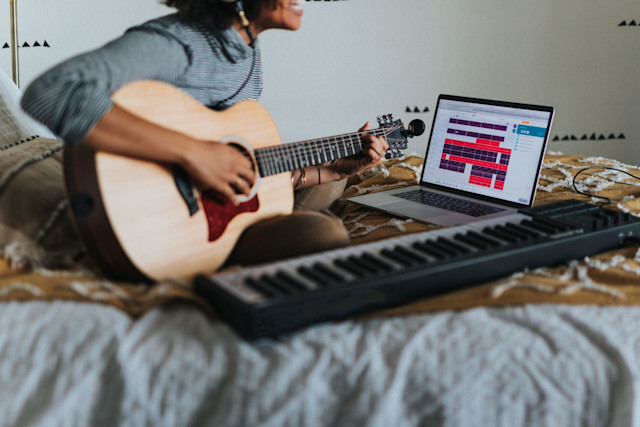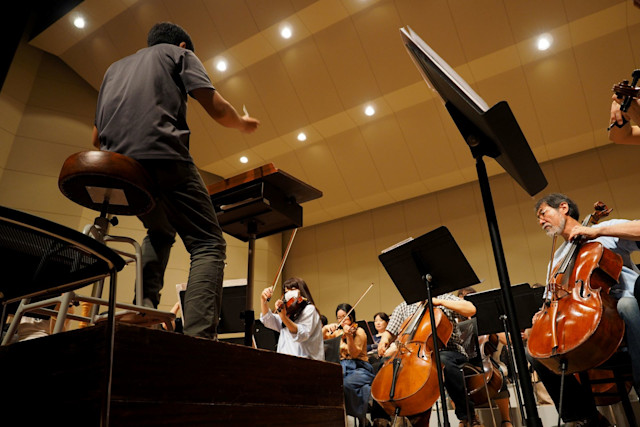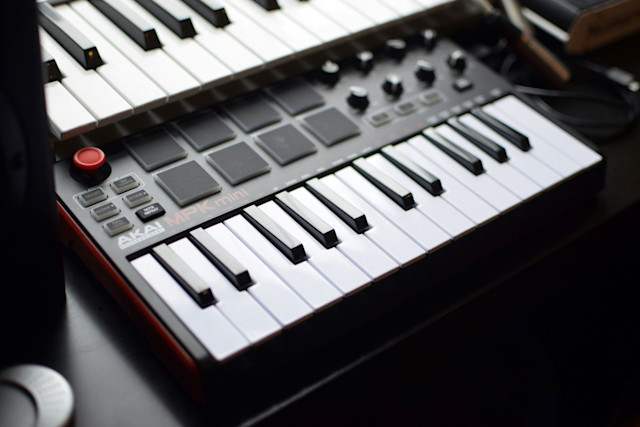The Only Things You Need to Learn to Use a Beginner DAW
November 11, 2024 - This short guide breaks down the 6 main things you need to learn how to do when you first start recording.

Getting started with digital audio workstations (DAWs) can feel overwhelming, especially with all the buttons, features, and endless tutorials that are out there... But don’t worry—you don’t need to know it all to start making excellent music! There are six core skills you need to learn to start recording, editing, and producing tracks.
New to Recording? Fear Not.
Getting started with digital audio workstations (DAWs) can feel overwhelming, especially with all the buttons, features, and endless tutorials that are out there... But don’t worry—you don’t need to know it all in order to start making excellent music! There are five core skills you need to learn to start recording, editing, and producing tracks.
This short and simple guide will walk you through these essentials, so you can dive into the world of music production without feeling frantic.
Ready to get started?
Let’s break down the basics!
Step 1: Figure Out How to Record and Import Sounds
First things first, make friends with your interface. Familiarize yourself with the layout, and locate these three things: The toolbar, the timeline, and an individual track. From there, you’re ready to start making or adding in sound.
Know that you don’t need to have the best of the best to get a nice sound. Even using a phone with the Soundtrap Studio app will work just fine. If you want something a bit more high-res, consider getting a basic USB microphone, and connecting it to your DAW via a computer. From there, recording with a click-track is as easy as choosing a tempo, and hitting that little red circle- record!
You can record using your phone, or an economical microphone
Most DAWs have a similar method of importing: Click and drag or file>import
To import sounds, many DAWs have a drag-and-drop feature, which means you can simply pull in an audio. You can also add sound from ‘file’ generally speaking.

Step 2: Learn How to Do Light Editing
Learn the basics: Cutting tracks, fading in and out
Add compression, EQ, reverb
Don’t make it “comp-licated”
Editing and comping tracks can be complex, but it does’t have to be. One ‘big’ thing to know when recording is that most flawless-sounding songs on the radio are a collection of hundreds of splices of recordings. When you record many tracks, and cut and take the best sections, this is called comping.
If you’re a beginning, don’t get too invested comping right off the bat. You still have a lot to learn. I find that comping as a beginner can make one easily frustrated, plus it’s hard to stay organized with pieces of tracks upon tracks. Don’t try and by Billie Eilish and Finneas on day one. Start by editing your track basically…
Snip out unwanted noises, adding fade-outs and fade-ins to make it sound more natural. Then, pepper in the following: Compression, a basic equalizer and reverb. In Soundtrap, you can add in these three things quickly and easily. And honestly? Pretty much any one you choose will sound good! To tweak them, there are hassle-free dials located right underneath the track.
3: Create a Pyramid of Sound In Your Song
This bullet point might be the only thing in this article that you haven’t heard of yet. And that’s because I’m pulling it from my classical background.
In an ensemble, obtaining the pyramid of sound is a goal for sonic balance. Here’s what it means:
The lows are the loudest (Think: Tuba, euphonium, percussion/timpani)
The mids are in the middle (Saxophone)
The highs are the quietest (Flutes, Piccolo, Oboe)
Well, it’s not secret that you probably won’t be using tuba’s or double reeds. However, the pyramid of sound is a valuable lesson in mixing and composition no matter the style.
Here’s what you don’t what to do in electronica: Add 5 loud and high-pitched synths and only have one bassline. Yikes. Then, it won’t matter how brilliant your tune is through the lens of chordal structure, timbre, or anything, because it will never sound right!
That’s because would have top-heaby mix, which is unnatural. As you are recording, deeply consider how many high electronic instruments you are using vs lows and mids. If you plan to have many moving upper lines, turn their volume way, way down. Speaking of electronic instruments and pre-made loops…How do you make them sound good?

4: Use MIDI and Loops & Making them Sound Natural
Using MIDI instruments is usually as simple as choosing the sound you wantand playing the notes on the keyboard inside the DAW. The only problem is…This might not end up sounding like how you imaged. But that’s ok, that doesn’t mean you need to trash it. Here are some things to try in order to improve the sound:
Use humanize tools for MIDI
Add reverb to dull-sounding MIDI instruments (or loops)
Use EQing if anything sounds unbalanced (too much high, mids, or lows)
Free sound libraries may have tons of loops…but how do you make them sound good? Same goes for MIDI instruments…All too often the sound is *close but no cigar*. The other day I found a great violin loop, but the quality of the room it was recorded it was subpar. Luckily, it wasn’t anything a little reverb couldn’t fix. I boosted the mids a bit too, and voila, it was like an orchestral violist was standing in my living room.
Know that not all DAWs are created equally. Soundtraps drag-and-drop style loop library automatically converts tracks into the key your song is already it, which is a huge time-saver. Plus, there’s thousands of high-quality loops and one-shots.

Pro Tips: Stay Organized, and Reference “The Greats”
Try: Organizing Tracks In Score Order
New producers may have trouble keeping organized in a more involved project with lots of tracks. Placing tracks in score order before mixing is a good place to start. For example, high-pitched and melodic instruments and lines can go at the top, mids in the middle, bass at the bottom, and percussion tracks below that. Some people also like to color code their tracks in a gradient. After you’re organized, it’ll be easier to work in your DAW.
Use a Reference Track, Listen Intently
Find your favorite song in a niche that you’re composing it, and listen to it deeply. Compare it to your tune, and notice what’s different.
In fact, there’s a lot you can learn from listening to excellent producers, even across different eras and genres. From the crazed-and-morally-questionable Phil Spector (1960’s) to Finneas, broadening your listening horizons and trying to recreate things are some of the best ways to learn.
6: Adding Basic Effects
Get schooled on how to use basic effects: Reverb, chorus, delay, modulation, distortion. In Soundtrap, you can just pull these in, and tweak the visual dials until you hone in the sound. There are also excellent vocal presets that will get you sounding fire…and right away, too.
Equalizing
One of the most essential recording tools is an equalizer. This tool allows you to adjust the levels of the highs, mids, and lows in a given track. This visual EQ makes the task easy.
So…Why is it even necessary?
The thing with recording is that microphones are like cameras… Cameras take photos of our surroundings, but by nature, the colors are a bit distorted. Microphones are the same way, except sound. It captures the sound, but it might distort it and make it brighter, darker, or unbalanced. Each microphone, like each camera, distorts it in a different way. Some (very expensive) ones might do so in a way that’s not detectable. But if you’re using your phone, the high range of any instrument is going to need a bit of tweaking to say the least.
7. Mixing & Mastering
Mastering unifies your music throughout your track and prepares it to be distributed across different formats, like Spotify streaming. Unlike audio mixing, which happens at the beginning of post-production to blend together tracks using EQ, compression, and other music-making elements, mastering is the “final touch” of music production. During mastering, your music is balanced to create the finished product that people want to hear. -Soundtrap/Music Mastering
Mixing vs, Mastering can be separate career of their own. But for all intents and purposes, let’s look at what you need to know to DIY-it. The end goal is to create a balanced and fresh, radio-ready sound.
But how do you achieve that? A lot of it is in volume adjustments. Think back to the pyramid of sound.
Once your mixing is done, you’ll have a complete track- or mixdown. Mixing can also include compression, Eqing, and the addition of reverb, on top of levels.
Mixing and mastering are two different things, usually done by at least 2 people. Mastering is the very last step. Nowadays, many beginner producers use AI or other automated tools. But be careful, sometimes this results in an overly-loud, fuzzed-out mix (Cough, I’m looking at you, Distrokid, you can’t mix woodwinds to save your life…) Ahem. I digress. Use your ears. The DIY process might look like this:
Export the file (the mixdown)
Impove the song by using things like stereo widener, limiter, and saturation…
Check back with your original tune and see if it sounds more polished
If you’re not happy with it, go back and continue to tweak until it sounds better than the mixdown
Sure sounds like a lot, doesn’t it?
DAWs like Soundtrap have a mastering tool built it, so you don’t have to keep going back and forth and tweaking your song ‘til the sun comes up.
Things You Need to Use a DAW: Conclusion
While opened up a DAW might feel like opening up Blender or Photoshop for the first time- Something that is easy to get lost in, full of buttons, and overwhelming…It doesn’t have to be scary.
All you need to know is how to do these 6 things:
Record and import tracks
Lightly Edit tracks
Stack sounds using the pyramid of sound
Make MIDI instruments and loops sound natural
Add basic effects
Make a rudimentary mix and run that through a mastering tool
And remember, follow basic emotional hygene tips like taking breaks during recording will go a long, long way in aiding your creative process.
At the end of this, you might still be asking yourself…What DAW should I be using as a beginner?
To get started recording today, consider trying Soundtrap. It’s the world’s first cloud-based DAW, and it’s very intuitive to learn, even if you’re a complete music newbie. With this program, you don’t need to have years of mixing, mastering, or performance experience to create a high-quality mix that people will love…So why not start today?
Check it out here with a free trial.
About the author
Aleah Fitzwater is a multi-instrumentalist, songwriter, music journalist, and blogger from Temperance, United States. Aleah holds a Pk-12 instrumental music education degree. Her main instruments are flute, piano, drums, bass, and guitar.
Get started with Soundtrap today!